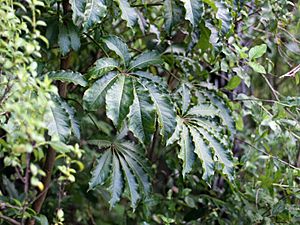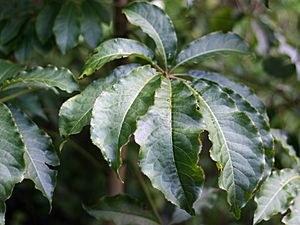Patē facts for kids
Quick facts for kids Patē, seven finger |
|
|---|---|
 |
|
| Scientific classification | |
| Genus: |
Schefflera
|
| Species: |
digitata
|
 |
|
| Natural range of Schefflera digitata | |
The Patē (pronounced pah-TEH), also known as the seven-finger or umbrella tree, is a special tree found only in New Zealand. Its scientific name is Schefflera digitata. The Māori people have several names for it, like patē, patatē, patete, and kōtētē.
This tree is part of the Araliaceae family. It grows in forests from sea level up to 1200 meters high. You can find it across the North Island, South Island, and Stewart Island. Patē likes damp, shady spots in the forest. It often grows near streams and on the sides of shady forest roads. It is the only type of Schefflera tree found in New Zealand. There are about 200 other Schefflera species, mostly shrubs and small trees, that grow in warmer, tropical parts of the world.
What the Patē Tree Looks Like
The Patē is a small tree that can grow up to 8 meters (about 26 feet) tall. It has strong, spreading branches. Its leaves are very unique. They look like an open hand with several "fingers." Each leaf can have anywhere from three to nine smaller leaves, called leaflets.
These leaflets are thin and soft when you touch them. Their edges are sharply serrated, meaning they have small, sharp teeth like a saw. When the tree is young, especially in the northern part of the North Island, its leaflets might be divided into even more irregular, toothed shapes.
The Patē also produces large groups of small, greenish flowers. These flowers grow on a big, branched stem called an panicle, which can be up to 35 centimeters (about 14 inches) wide. The flowers are grouped together in small clusters called umbels. Each umbel can have up to ten flowers, and each flower is about 7 millimeters (less than half an inch) across. After the flowers, the tree grows dark violet fruits. These fruits are round and fleshy. They are about 3.5 millimeters (about 0.14 inches) wide and have grooves when they dry. It takes about two or three months for the fruits to ripen.
How Patē is Used and Its Place in Nature
The Patē tree has been used for different things. The sap from the tree was used in traditional medicine. It helped treat skin problems like ringworm and sores. The Māori people also used the wood from the Patē tree to make fire by rubbing pieces of wood together.
The Patē tree is also very important because it is the main host for a special parasitic plant called Dactylanthus taylori. This plant is also known by its Māori name, pua-o-te-reinga, which means 'the flower of the underworld'. The Wood rose is a root parasite, meaning it grows on the roots of other plants, like the Patē, to get its food.
Sadly, the Wood rose is in danger of disappearing. One reason for this is that some people illegally collect the plants to sell them as interesting items. Even though Patē is easy to grow in New Zealand, it's not very popular in gardens. Its thin, soft leaves aren't as shiny and attractive as other similar plants, like the Pseudopanax species or the Australian Schefflera actinophylla.
Sometimes, gardeners in colder parts of the world try to grow Patē, hoping it can handle cold weather. However, like many trees from New Zealand, Patē doesn't do well in long periods of cold.
See also
 In Spanish: Siete dedos para niños
In Spanish: Siete dedos para niños


